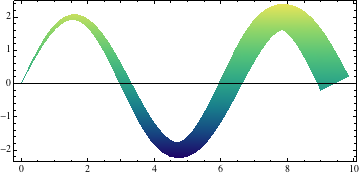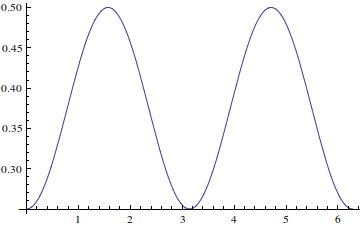the newest edit
thicknessFunction is not compatibile with ColorFunction. It is because Mathematica is creating GraphicsComplex for plots with ColotFunction.
I have created procedure which is dealing with it. It is more useful than thicknessFunction[f_, f2_] from the bottom of this post because MMA is taking care for scalling etc.
thick$color[f_] := ReplaceAll[#,
GraphicsComplex[x_List, y_List, z : OptionsPattern[__]] :>
GraphicsComplex[
x,
(y /.Line[x2_List,z2 : OptionsPattern[]] :> (Sequence @@ (
{Thickness[f @@ (Mean /@Transpose[x[[#]]])],
Line[#, VertexColors -> Automatic]} & /@ Partition[x2, 2, 1]))),
z]] &;
ParametricPlot[{Sin[t]+2 Sin[2 t], Cos[t]-2Cos[2t]}, {t, 0,3 Pi}, PlotPoints -> 500,
MaxRecursion -> 1, Axes -> False, ColorFunction -> "Rainbow"
] // thick$color[.01 (Abs[#1 #2]) &]

ParametricPlot[{Sin[t]+Sin[15t], Cos[t]-Cos[15t]}, {t, 0, 3 Pi},PlotPoints -> 2000,
MaxRecursion -> 1, Axes -> False, ColorFunction -> "DarkRainbow"
] // thick$color[.01 (Norm[{##}]) &]

Before last edit
With Your request:
[...] twice as thick at the minima and the maxima as it is at the roots. [...]
Artes's approach seems to be natural, because You can implement thickness dependance of function absolute value, function's derivative, or even argument value just by including those into first list in Plot.
However, it could be challenging if one does not feel good in analysis.
I think it is a good moment to try to create something like ColorFunction for plot thickness. It is my solution:
thicknessFunction[f_] := ReplaceAll[#, Line[x__] :> (
{AbsoluteThickness[f @@ (Mean /@ Transpose[#])], Line@#} & /@ Partition[x, 2, 1])] &
OP's function case
In Your case such function should have form f = Function[{x,y}, 7 + 7 Abs[x]]. Then thickness for y = 0 is 7 and twice as much, 14, for y = 1. So simple because Sin is quite predictable :).
Following example is for 3 times thicker at extremes (just for clarity).
f = Function[{x, y}, 5 + 10 Abs[y]]
Plot[Sin[x], {x, 0, 3 Pi}, PlotPoints->500, MaxRecursion->1] // thicknessFunction[f]

Explanation
Note that many PlotPoints and MaxRecursion->1 is a must for smooth result. thicknessFunction is working on sample points and if we want smooth plot we need many but quite uniformly sampled points. Take a look:
(Plot[5 Sin[x], {x, 0, 10 Pi}, ImageSize -> 300, PlotPoints -> #1,
MaxRecursion -> #2] /. Line -> Point) & @@@ {{100, Automatic}, {100, 1}, {500, 1}}
 Then we have to just replace those points to lines with thickness specified by us.
Then we have to just replace those points to lines with thickness specified by us.
Examples
y = x with thickness proportional to x^2 and x
plot = Plot[x, {x, 0, 30}, AspectRatio -> 1, PlotPoints -> 500, MaxRecursion -> 1,
ImageSize -> 300];
plot // thicknessFunction[.4 #1^2 &]
plot // thicknessFunction[2 #1 &]
OP's case variations. Even including some analysis.
plot = Plot[Sin[2 x], {x, 0, 3 Pi}, PlotPoints -> 500, MaxRecursion -> 1,
PlotRange -> {{-2, 12}, {-1.5, 1.5}}, Frame -> True, Axes -> False];
plot // thicknessFunction[Abs[10 Sin'[2 #1]] + 2 #1 &]
plot // thicknessFunction[10 (#2 + 1) &]
Limitations
I have not tested it with all graphics functions in Mathmematica :) so I have to assume it is not bulletproof.
Important remark - it will not cooperate with ColorFunction but:
color plot
Stealing halirutan's example lets implement colors:
thicknessFunction[f_, f2_] := ReplaceAll[#, Line[x__] :> (
{Blend["Rainbow", f2 @@ (Mean /@ Transpose[#])],
Thickness[f @@ (Mean /@ Transpose[#])],
Line@#} & /@ Partition[x, 2, 1])] &
ParametricPlot[{Sin[t] + 2 Sin[2 t], Cos[t] - 2 Cos[2 t]}, {t, 0, 3 Pi},
PlotPoints -> 2000, MaxRecursion -> 4, Axes -> False, ImageSize -> 500
] // thicknessFunction[.01 (Abs[#1 #2]) &, Abs[#2/2] &]
This have to be optimized and I must work on scalling etc. But do not have time now :(












 Then we have to just replace those points to lines with thickness specified by us.
Then we have to just replace those points to lines with thickness specified by us.




